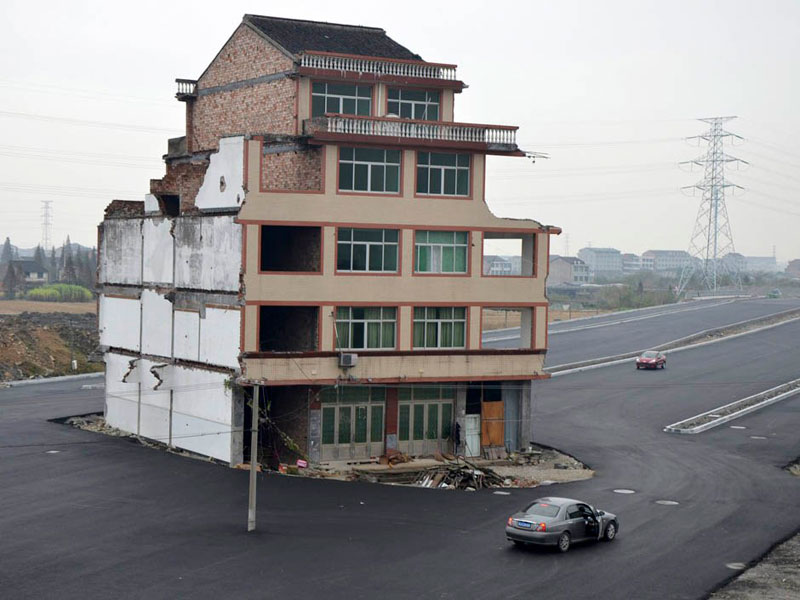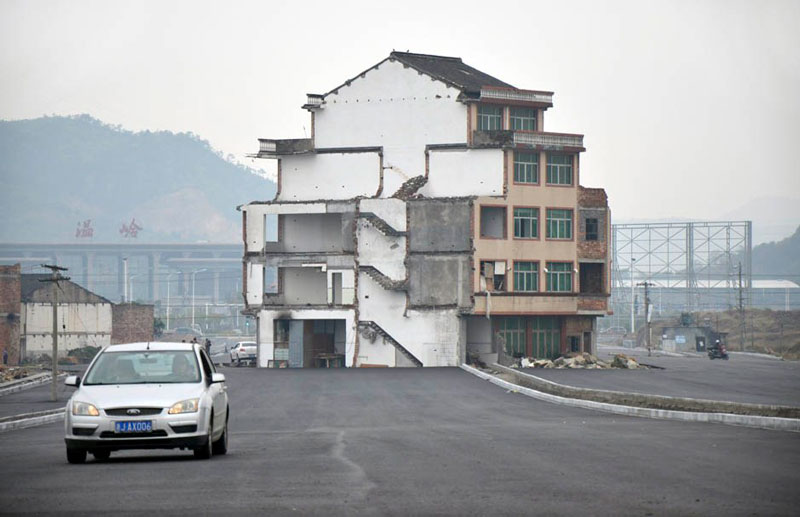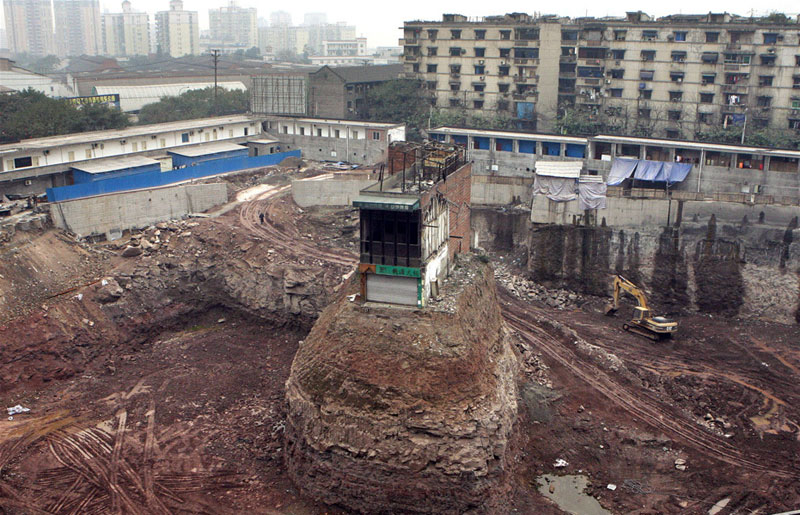The architecture of spite — bricks, mortar and raw emotion
With a strengthening economy and the rise of free markets beginning in the late 1990s, private developers began building shopping malls, hotels, and other private developments in densely populated urban centers, which required displacing residents who lived on the land. Developers would typically offer relatively low compensation to the residents, reflecting the pre-development value of their properties or the cost of obtaining alternate housing elsewhere. Should residents resist, or try to take advantage of their bargaining position, powerful developers could persuade local officials and courts to order residents off the land. In other cases, residents would be arrested on false charges or thugs would be hired to scare away the residents. [Source]
TwistedSifter
The Best of the visual Web, sifted, sorted and summarized
China Builds Highway Around House That Refuses to Move

In the city of Wenling, located in China’s eastern province of Zheijang, a highway has been built around a residential building that refuses to relocate. Luo Baogen, unsatisfied with the relocation compensation offered by the government decided to remain in the half-demolished building with his wife. According to China Daily, the road, which leads to the Wenling Railway Station, hasn’t been put into use yet.
Even though all of the other residents have moved out, the government has not demolished the other rooms for sake of the remaining couple’s safety.

According to the National Post (where you can find more picture and detailed information), these buildings that refuse to move for new developments are called ‘nail houses’ in reference to old, gnarled nails that cannot be easily removed.
Every couple years, these defiant ‘nail houses’ make the rounds online. They serve as a symbolic testament to the ‘little guy’ standing up against the government and pushy developers.

According to Wikipedia: In the People’s Republic of China, during most of the Communist era, private ownership of real property was abolished. The central government officially owned all real estate, and could in theory dictate who was entitled to control any piece of property according to national interests. Private citizens, therefore, did not have a legal right to keep their property if the government decided they should leave (although in practice, entitlements arose for various reasons).
With a strengthening economy and the rise of free markets beginning in the late 1990s, private developers began building shopping malls, hotels, and other private developments in densely populated urban centers, which required displacing residents who lived on the land. Developers would typically offer relatively low compensation to the residents, reflecting the pre-development value of their properties or the cost of obtaining alternate housing elsewhere. Should residents resist, or try to take advantage of their bargaining position, powerful developers could persuade local officials and courts to order residents off the land. In other cases, residents would be arrested on false charges or thugs would be hired to scare away the residents. [Source]
Spite nail house

Try unlimited access
Try full digital access and see why over 1 million readers subscribe to the FT- Then 65 € per month
- New customers only
- Cancel anytime during your trial
What is included in my trial?
During your trial you will have complete digital access to FT.com with everything in both of our Standard Digital and Premium Digital packages.
Standard Digital includes access to a wealth of global news, analysis and expert opinion. Premium Digital includes access to our premier business column, Lex, as well as 15 curated newsletters covering key business themes with original, in-depth reporting. For a full comparison of Standard and Premium Digital, click here.
Change the plan you will roll onto at any time during your trial by visiting the “Settings and Account” section.
What happens at the end of my trial?
If you do nothing, you will be auto-enrolled in our premium digital monthly subscription plan and retain complete access for 65 € per month.
For cost savings, you can change your plan at any time online in the “Settings and Account” section. If you’d like to retain your premium access and save 20%, you can opt to pay annually at the end of the trial.
You may also opt to downgrade to Standard Digital, a robust journalistic offering that fulfils many user’s needs. Compare Standard and Premium Digital here.
Any changes made can be done at any time and will become effective at the end of the trial period, allowing you to retain full access for 4 weeks, even if you downgrade or cancel.
When can I cancel?
You may change or cancel your subscription or trial at any time online. Simply log into Settings and Account and select “Cancel” on the right-hand side.
You can still enjoy your subscription until the end of your current billing period.
What forms of payment can I use?
We support credit card, debit card and PayPal payments.
]]>